Preparing clematis for winter, proper pruning and organizing shelter
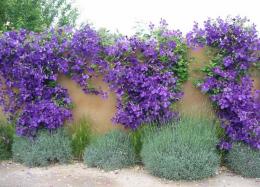
Clematis can be called the most beautiful climbing plants that decorate summer gardens. The beauty of flowers and the variety of their colors are simply mesmerizing. Flower lovers have been growing them in their gardens and summer cottages for decades.
These climbing flowers are mainly used to decorate gazebos or fences. Unfortunately, not everyone knows that different types of clematis require different types of autumn pruning and the organization of proper winter shelter.
But this is precisely the main condition for the growth of the vegetative mass of the plant and the abundance of flowers on it next summer.
The article will tell you about ways to properly prepare for winterwhen it is necessary to cover them, about proper pruning, how to remove a plant from a trellis, about the correct organization of winter insulation, about caring for a flower in winter.
Content
- Features of preparing clematis for wintering
- Types of pruning
- Pruning methods depending on the type of plant
- How to remove clematis from a support
- Shelter for the winter
- How to preserve young clematis
- How to care for clematis in winter
- How to properly remove cover from clematis
Features of preparation for wintering
Preparation clematis for winter is one of the important elements of caring for these amazing flowers. This process must be treated with great attention and everything must be done correctly.
The preparation process includes several stages:
- pruning;
- treatment;
- insulation.
Preparations must begin in advance. Recommended period: end of August – beginning of September. By starting preparatory activities during this period, you can manage to carry them out efficiently and on time.
In the fall, before covering the clematis, the bushes and soil around them, for preventive purposes against the development of fungi, need to be treated with a foundation solution, dissolving 20 grams of the drug in 10 liters of water, sprinkle with wood ash and loosen the soil around the plant to a depth of 15 centimeters. The bush needs to be covered peat, humus or compost, in the amount of 2-3 buckets.
Answering the question at what temperature it is necessary to cover clematis, experienced gardeners recommend doing this at a temperature of 5-7 degrees below zero. For shelter, you need to use an air-dry method, this will help avoid getting wet and damping off the roots.
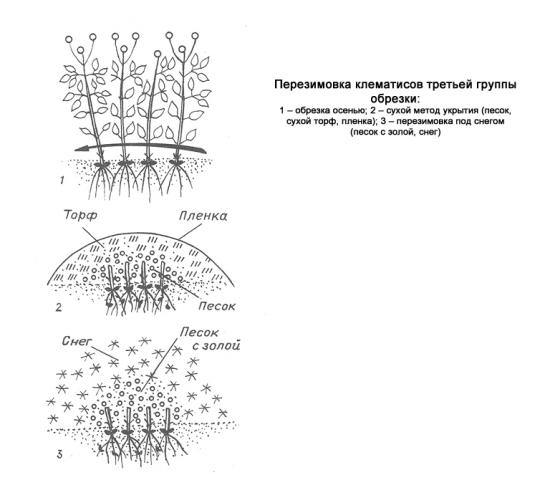
In warm areas and where winters have frequent thaws, there is no need to heavily insulate these flowers. They need to be ventilated periodically.
Types of pruning
Trim clematis in the fall it is necessary for the full development and formation of roots. When carrying out this procedure, it is necessary to take into account the characteristics inherent in different varieties of this perennial. Thanks to this, in the new season it will delight its owners with an abundance of flowers.
It is strongly recommended to prune the bush no later than 2-3 weeks before the onset of cold weather.
Trimming has several types:
- sanitary – removal of damaged and dried lashes is carried out;
- formative - gives the bush its shape, helps improve growth and abundant formation of flower buds;
- winter - helps the bushes endure the winter period, thanks to it increases resistance to freezing.
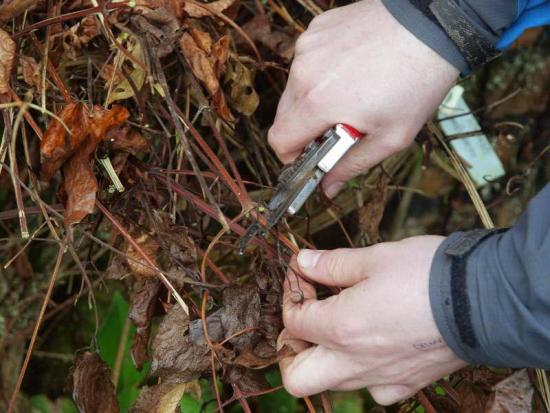
Pruning these climbing garden inhabitants in the fall simplifies the process of insulation for the winter period, which will protect them from frost. In addition, such pruning helps to rejuvenate the bushes. In the spring, young shoots will grow on them, on which flower buds will form, but this rule does not apply to all varieties of clematis.
Pruning methods depending on the type of plant
The main role in pruning is played by features associated with the formation of buds on the vines of the bush and further flowering.
These flowers are divided into three groups:
- the formation of flowers occurs on sprouts grown last year: Cardinal Rouge, Hegley Hybrid, Princes and others;
- buds are formed on stems that grew last season, from May to mid-July, and after that buds formed on new stems begin to bloom: Minister, Flower Ball, Fair Rosamund, Dawn, President;
- the formation of buds occurs on the vines grown in the new season: Jacquemant, Vititsella, Victory Salute, Ville de Lyon, Gypsy Queen, Cosmic Melody, Tuchka
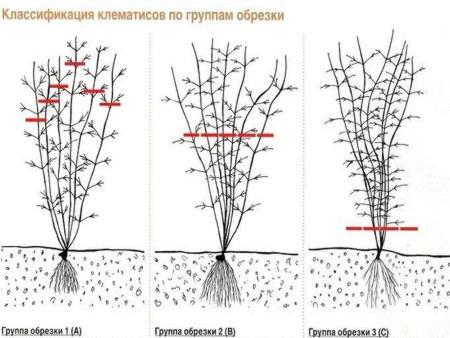
Bushes belonging to the first and second groups must be trimmed with great care. It is necessary to leave the strong lashes that have grown this year. Flower buds will appear on them next summer. The stems of these plants are cut, leaving a height of 110-120 centimeters.
At the same time, you need to carry out sanitary pruning, removing dried, broken and damaged lashes. These garden flowers do not shed dried leaves on their own, so they need to be cut off with scissors during autumn pruning.
Plants that are included in the third group must be subjected to almost complete pruning, leaving shoots 18-20 centimeters in length, which corresponds to 2-3 buds. In the spring, new shoots will begin to grow from them.
How to remove a vine from a support
It is especially difficult to remove a large thickened bush from its support clematis. To facilitate this task, it is necessary to tie the young lashes to the support on one side in the spring.
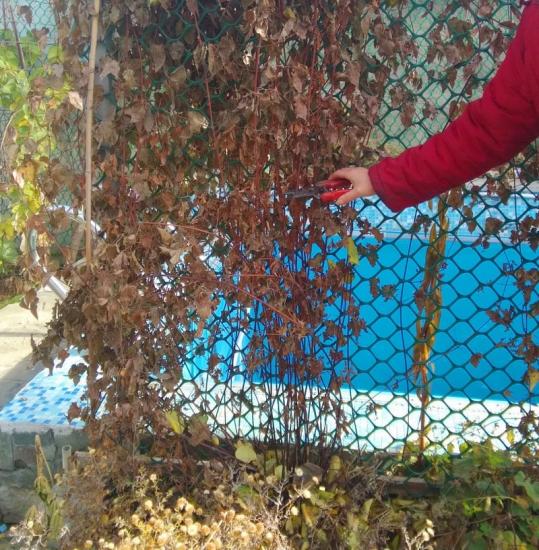
They cannot be intertwined with support rods. Over the summer, they will grow greatly and become intertwined so that in the fall, without breaking them, it will not be possible to remove them.
With this method of gartering, when the time comes to remove the bush from the trellis, you will need to trim it at a height of about 1.5 meters, and then cut the ropes with which the shoots were tied. At the same time, it is necessary to cut off all the leaves that hold the plant to the trellis.
Shelter for the winter
You can insulate clematis for the winter in the same way as grapes. The only difference is the timing. The flower needs to be insulated much later than the grapes. It is necessary to cover climbing flowers in late October - early November, and in some areas of our country these activities can be carried out at a later date.
The plant can easily withstand the first slight frosts, but it still needs to be insulated. In areas with little snowy winters, flower shoots are susceptible to freezing.
Covering must be done by first trimming and treating the plant's vines. There are several methods of insulation. Their use depends on various factors. Branches are perfect for this, peat, sawdust, dry leaves, some artificial materials. It won’t be bad if you pour dry earth onto the insulation layer, and when the snow cover appears, heap more snow onto the pile.
It is very important that the insulation is not tight; air access must be provided to the plant.If this is not done, then it is possible that by spring the plant will spray.
The type of plant and the method of formation of flower buds on it are reflected in the quality and method of its insulation:
- when flowering on last year's shoots, it is necessary to take into account the level frost resistance this type of clematis. Frost-resistant varieties have become widespread; they are often left to spend the winter without being removed from their supports. Flowers of such varieties need to be earthed up in the fall. This will help protect the roots from frost. The heap of earth or aerated peat poured onto the bush should be about 40 centimeters; for this it is recommended to use only dry soil;
- if the formation of buds occurs on young and last year's shoots - after pruning, they must be removed from the support for the winter, hilled up, thus, as in the first option, the shoots are carefully rolled into a ring, placed on the ground, sprinkled with dry leaves. In addition, the resulting slide must be covered with lutrasil or agrofibre;
- when the plant belongs to the group where buds form on young shoots, after pruning the bush only needs to be spudded. There is no need to cover the plant.
How to preserve young clematis
To preserve a young plant in winter, you must adhere to the following rules:
- in the fall, prune the lashes, leaving 3-4 buds on the shoots, regardless of its type of bud formation;
- cover with branches and then with plastic film, which will protect the sprout from excess moisture. Before insulation, be sure to cover the bush with dry soil;
- a small young plant can be covered with a large flower pot, which can be topped with spruce branches and covered with wood shavings and sawdust.

How to care for clematis in winter
Provided that all pruning and insulation measures were carried out in a timely manner and correctly, they will not need to be taken care of during the winter period. But in case of a cold and little snow winter, it is necessary to shovel snow onto the bushes.
In warm winters, you need to check whether the bushes are flooded with water. If such a situation arises, you need to put something under the shoots, maybe boards or pieces of foam, which will protect them from falling into the ice.
Along with this, there is a possibility that small rodents - mice - will live under the shelter. If traces of their appearance appear, you need to scatter the poison. These pests can chew off the flower sprouts.

How to properly remove cover from clematis
It is necessary to remove the cover from plants with the onset of warm weather, even if stable drops in temperature remain at night. Most of all, clematis are afraid of thaw and excess moisture. This promotes their damping off. The bushes simply need access to fresh air. Usually they begin to remove insulation from plants in April and finish in May.
They need gradual adaptation and habituation to sunlight.
Removing insulation is divided into several stages, dividing them over several days. First, open the holes for ventilation. It is produced only on warm days. The film and top layer of insulation are removed after the threat of severe night frosts and snowfalls has passed.
There is no need to rush to clean up the hilling. Plants need to get used to new conditions. After a few days, part of the mound can be removed. The rest of the soil can be removed only after the night frosts have completely disappeared.
Sometimes in the spring, after removing the cover, it turns out that the flower was not preserved and disappeared, but hurry to dig it up root no need, there is a possibility that in 2-3 years it will begin to grow again. Dormant buds will be activated and clematis will grow again and delight with its flowering. If the bush has not shown signs of life during the summer, it must be insulated in the fall, and in the spring, perhaps, it will sprout.
Some gardeners transplant clematis to new places in the spring, choosing a sunny place where shade appears in the afternoon. The soil in the new location should be moderately moist, and the content of clay and sand in it should not be high.
Before planting clematis bushes, you need to deeply loosen the soil. This is done to ensure good drainage, which has a beneficial effect on the development and growth of clematis. It is imperative to install trellises to provide support for the shoots.
In spring, the flower needs help to restore its strength after winter, activate metabolic processes after winter slowdown and begin to actively grow. Frequent watering. Florists call this process “casting.”
Fertilizing with fertilizers, both mineral and organic, will also be useful.
Clematis are beautiful garden flowers; with proper care they will delight their owners for many years. When purchasing plant seedlings, do not forget to clarify their belonging to the zone winter hardiness, because this is the main reason why the plant may not survive the winter and die.
You can learn how to properly prune clematis for the winter from the video:

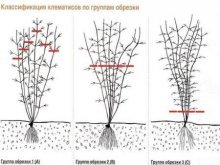
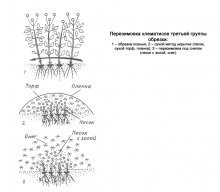
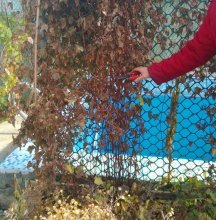
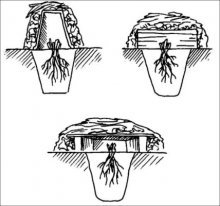
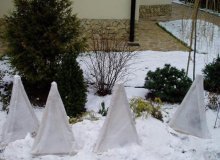
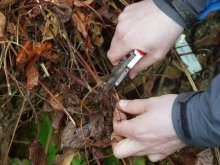
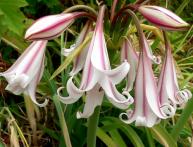



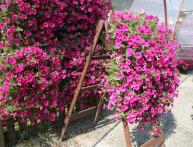

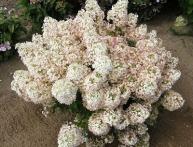
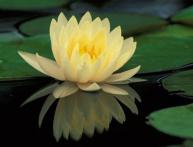
Comments
I cover clematis when the first frosts begin.I lay the stems down, cover them with old jackets or coats, and turn over an old bucket with a hole in the bottom on top. For several years now, clematis have been wintering well and do not die.